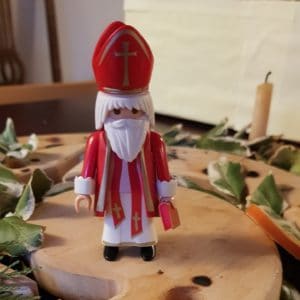 Maybe it was because I grew up in a protestant, evangelical tradition that I always thought anything to do with the saints was kind of catholic and probably a bit wrong.
Maybe it was because I grew up in a protestant, evangelical tradition that I always thought anything to do with the saints was kind of catholic and probably a bit wrong.
A few years ago, I went on a Godly Play retreat in which we explored twelve saint’s stories. To be honest, I wasn’t keen on the saint ‘stuff’, but the retreat sounded fab so I went anyway. Over 36 hours, we heard the life stories of twelve saints, one for each month of the year. Each was told in the classic Godly Play, slow, calm, visual, simple yet deeply meaningful way. Those two days completely changed my view on celebrating saints, and I started to integrate celebrating saint’s days into our faith at home traditions
We started with the most obvious ones like St Valentine and St Nicholas, and more recently, we’ve celebrated St Lucia, partly because I have a friend called Lucia, and we wanted to celebrate her and so we had a St Lucia party with some friends and explored the story of St Lucia. I wanted to share a little of what I’ve found to be helpful, in case it’s helpful to you.
What I’ve found it that the saints stories are far from being an addition to the Bible, they are like stepping stones which help me connect my story with the Bible story. The Bible is the story of God’s relationship with His people, but the story isn’t finished. It’s like the Never-ending Story – remember that film? The boy is listening to a story and suddenly realises he is inside the story, where his actions have an influence on what happens in the story. That’s a bit like what the Bible’s like, because although the canon is closed, ie the books which are ‘ratified’ as God’s word to us have been chosen and no more are being added, God’s story of himself and His people is not closed! In fact, God is adding people to His family, adding ‘new characters’ to the story every day! The saint’s stories help me to see my life and how God relates to me in a new way.
One of the things we were encouraged to do at the Godly Play retreat I went on was to write our story. So having heard 12 saints stories, we reflected as a group on the common themes and structure and content of those stories, which then helped us reflect on our own lives
Each story started by introducing the character by name, where and when (ish) they were born, something about their childhood or early life, and a revelation moment they had or significant spiritual event in their life which contributed to setting them in the direction of their life’s work. Each story then included 2 or 3 things which they did in their life, then summarised their life with a really snappy sentence – Augustine asked questions for God, Nicholas gave gifts for God.
We were challenged to see if we could do this for our lives, which was fun. What were the key things about my life, my childhood? What were the key events in my early life which contributed to the direction of my life work? Did I have a key revelation moment with God? What do I do for God? A phrase came into my mind: Victoria inspires people for God. I remember thinking – yes, that’s who I am! To be honest, it feels a bit pompous writing it down, but since then, every time I speak at an event, at least one person comes and tells me they were inspired. I thank them and smile, knowing that God is reminding me little me that I am doing my work for Him, and that I am part of the larger story of God and His saints.
In The Complete Guide to Godly Play Volume 7, there are 12 saints stories and they are quite easy to do at home, partly because if you’re wondered about learning the Godly Play scripts off by heart, you could at a push, read the saints stories. (Although because they each have physical objects you use to tell the story, it’s really much easier than I imagined to learn the stories and tell them without the book, which of course, is much clearer and easier for the listeners.)
The Godly Play selection is quite nice because it includes a higher proportion of women than you might otherwise get in a book about the saints. It also has a higher proportion of saints who are not martyred, which is nice. One of the things my friend called Lucia asked me to do at the party we had was not to do the detail of the gore of her death (It’s pretty horrible as she gets her eyes gouged out after they’d tried to set her on fire and found the fire didn’t light!) Even when I used the phrase “they had to find another way to get rid of her.”, one child wanted to explore the method they used and we had divert him from going down that path as it takes away from the story of the saint and their life for God. Telling the stories of the saints isn’t about the gore, but to look at their lives and how God worked through them.
A great book for exploring the saints in the Celtic Daily Prayer book which has great daily prayers but also a section for lots of saints, including some more modern ones such as Madeline L’Engel, who wrote The Glorious Impossible and A Wrinkle in Time.
The section is called A Model to Follow. I love this – as it’s helpful for us to have models to follow and be inspired by. I remember reading lots of Christian biographies – Chasing the Dragon, Corrie Ten Boom’s The Hiding Place, Vanya, and The Cross and the Switch Blade. I remember as a teenager those books inspired me to go all out for God. To really do things outside my comfort zone and expect God to work miraculously through me. I do this with my younger children with books like the series Little People Big Lives. The series isn’t Christian, although I’m sure some of the characters were, but it brings their lives, well, alive in a way that reading dry biographical facts wouldn’t. If you see any books like this about the saints, do let me know!
Interestingly, even though the chapter in the Celtic Daily Prayer book is called ‘A Model to Follow’, it specifically says in the introduction that we aren’t supposed to try and be like the saints, but rather look at their lives to see what we can discover about God. (This is also true, I believe, about bible characters, but that’s a slightly different topic!)
So how can we explore saint’s stories in our faith at home?
Start with saints we’re already a bit familiar with and explore them a bit more. This might be the saint of your church or school, or one with your name. Or you could start with saints whose days are already in our calendar, such as Valentine.
Research the life of your saint a bit, perhaps filling in details such as:
Name:
Born on:
Born in:
Something we know about their childhood:
A significant moment in their early life:
2/3 things they did in their ‘work for God’:
Summary: [Name] [did activity] for God.
You might like to keep the information like a report (as above) or re-write it in story form and perhaps make a little book or video of the story.
One way to remember the story is to pick three physical items to use to tell this story. For example, I will be drying and varnishing a crocus this Spring to use in the story of Saint Valentine, who gave a flower in a letter to the girl he loved. Saint Lucia wore candles on her head to help light her way as she brought food to the Christians in the catacombs, so we made felt crowns with felt candles on them, and attached a string of LEDs to light them! Saint Nicholas put bags of gold into the house of three young women, so we put golden chocolate coins in our shoes.
Research what traditions have grown up around your saint. On Saint Lucia day, Swedish people bake delicious saffron buns – worth doing even if you’re not celebrating Saint Lucia!
Explore ways you could share the story of your saint and perhaps a little kindness to someone, for example by baking heart shaped biscuits to give to someone who might be feeling unloved on Saint Valentine’s day.
